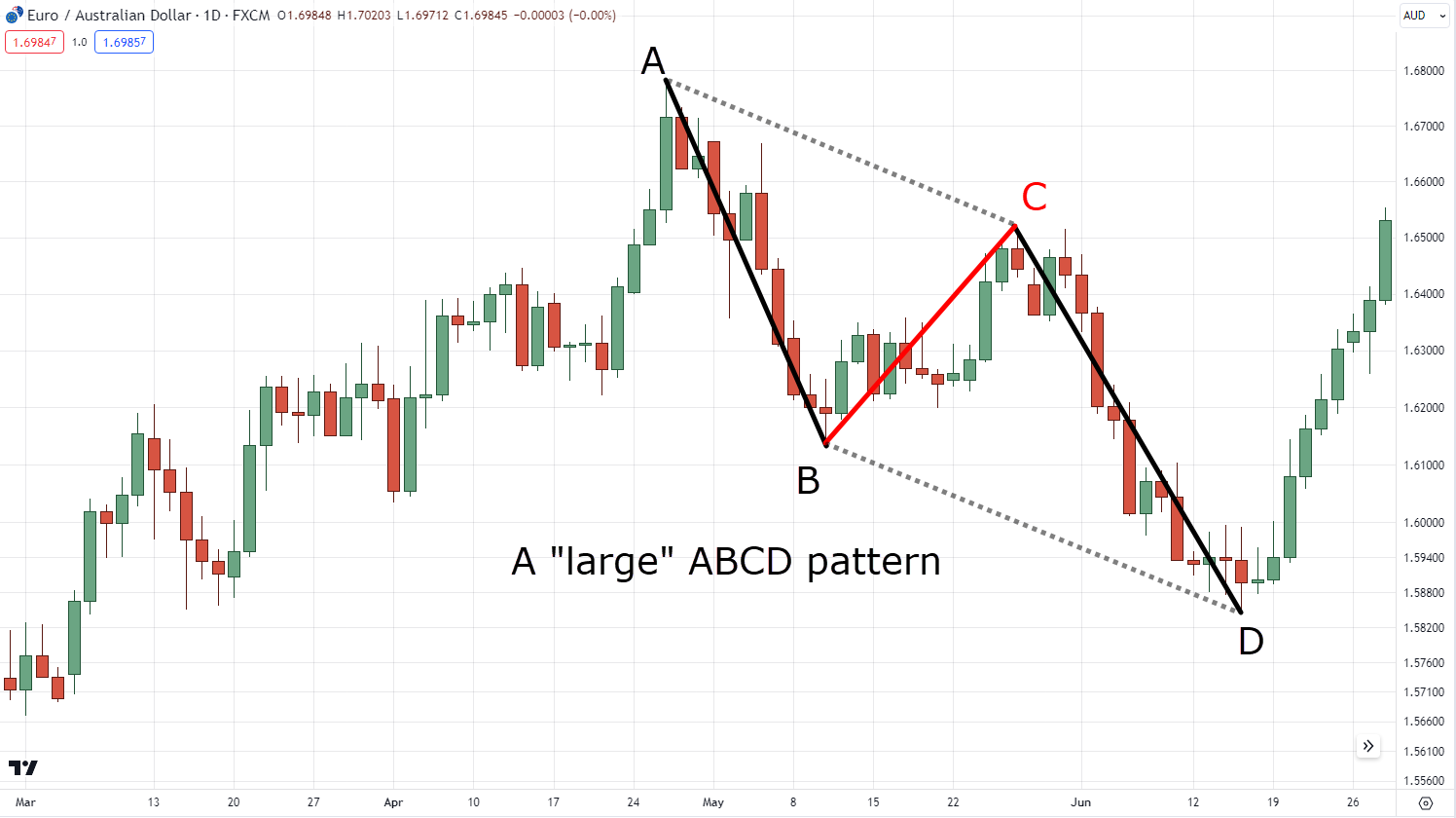In the dynamic landscape of financial markets, traders constantly seek dependable patterns to enhance their decision-making processes. Among these, the ABC pattern emerges as a noteworthy formation. When paired with Fibonacci ratios—specifically .328 and 1.27—this pattern provides crucial insights into price trends. This article will thoroughly examine the ABC pattern, discuss the historical importance of Fibonacci ratios, and offer practical advice on how to effectively incorporate these concepts into your trading strategies.
What is the ABC Pattern?
The ABC pattern is an important trading formation that indicates potential price reversals in the market. It consists of three main points: A, B, and C, each representing crucial price levels that traders watch closely.
Point A signifies the initial high or low in an existing trend and acts as the starting point for price movement. Next, prices pull back to Point B, which creates a correction or retracement. This step is vital for identifying possible entry and exit points. Finally, the movement reaches Point C, which can suggest either a continuation of the original trend or a reversal.
Traders aim to identify the ABC structure because it facilitates more informed decision-making based on market behavior instead of relying on emotional impulses. By understanding how this pattern interacts with Fibonacci ratios, traders can improve their ability to identify support and resistance levels within market dynamics.
The Fibonacci Ratio’s Historical Context
Fibonacci ratios have a fascinating history that dates back to the 13th century. The Italian mathematician Leonardo of Pisa, better known as Fibonacci, introduced these ratios in his influential book, Liber Abaci. This work presented the sequence that now bears his name, starting with the numbers 0 and 1, where each subsequent number is the sum of the two preceding ones.
The Fibonacci sequence is not just a mathematical concept; it also appears in various natural forms. For example, the arrangement of petals in flowers and the spirals of seashells exhibit this elegant numerical order found in nature. Over time, traders began to see how these ratios could be applied to the financial markets, leading to the discovery of crucial levels for price retracement and extension.
Some of the most commonly used ratios derived from the Fibonacci sequence include 0.618 (often referred to as the golden ratio), 0.382, and 0.236. As awareness of these ratios grew within trading circles, Fibonacci tools became vital for technical analysis, empowering traders to make informed decisions based on both mathematical principles and the inherent patterns found in nature.
How to Determine Fibonacci Levels
Calculating Fibonacci levels is a simple process once you understand the fundamentals. Here’s how to do it step by step:
- Identify Significant Price Swings: Start by pinpointing a major price movement—usually a peak and a trough on the asset’s price chart.
- Measure the Distance: Next, calculate the distance between these two points. This measurement will serve as your baseline for further calculations.
- Apply Key Ratios: Use the essential Fibonacci ratios—23.6%, 38.2%, 50%, 61.8%, and sometimes 78.6%. Multiply the distance you measured by each of these ratios to uncover potential support and resistance levels.
- Adjust Based on Direction: Depending on whether the price is moving up or down, you will either add or subtract these values from your starting point.
- Chart the Levels: Finally, plot these levels on your price chart. These markings can indicate crucial areas where the price may either reverse or continue its trend.
Additionally, by exploring various time frames, traders can uncover different patterns that may emerge in short-term versus long-term strategies, helping to refine their trading techniques.
Knowing the 1.27 and.328 Ratios
The .328 and 1.27 ratios are vital elements of the Fibonacci sequence that traders frequently use to pinpoint potential reversal points in the market. These levels are based on mathematical relationships observable in nature, which makes them intuitively appealing.
The .328 ratio indicates a pullback of roughly 32.8% from an initial price movement, suggesting a minor retracement before the trend potentially resumes. This level is crucial for traders seeking buying or selling opportunities.
On the other hand, the 1.27 ratio signals an extension of around 27% beyond the original price movement. This ratio serves as a valuable tool for predicting future price targets when market momentum changes direction.
Incorporating these ratios into trading strategies allows for a more sophisticated approach, improving decision-making amidst volatile market conditions. A clear understanding of how these ratios interact with price movements is essential for effectively leveraging emerging trends.
Use of Fibonacci Ratios in Real-World Applications
Fibonacci ratios have emerged as essential instruments in trading, providing valuable insights into possible price movements. Here are some practical ways to utilize these ratios effectively:
Finding the Main Levels of Support and Resistance
Traders often rely on Fibonacci retracement levels to identify potential points where the market could change direction. When prices near these key areas, it typically creates a chance for traders to enter a position, expecting a rebound.
Projecting Future Price Objectives
Fibonacci extensions help traders forecast future price targets after a notable price shift. By utilizing these extensions, traders can develop more effective strategies for taking profits.
Combining Additional Technical Indicators
Integrating Fibonacci ratios with additional technical indicators can strengthen your decision-making process. For example, aligning signals from moving averages or momentum indicators can greatly boost the precision of your trades.
Analysis of Multiple Time Frames
IIntegrating multiple time frames into your analysis provides an added layer of insight. Short-term trades can take advantage of rapid adjustments, while long-term strategies benefit from the clearer perspective of overarching trends illustrated by Fibonacci levels.
How to Use Fibonacci Ratios in Trading Effectively
Grasping Fibonacci ratios is merely the beginning. To leverage them effectively within your trading strategy, consider these practical tips:
- Identify Significant Levels: Start by recognizing key support and resistance levels. Fibonacci retracement levels often indicate where price reversals may occur.
- Monitor Market Trends: Stay attuned to market trends. When a trend coincides with a Fibonacci level, it can suggest a stronger likelihood of reversal or continuation.
- Incorporate Additional Indicators: Use supplementary indicators like moving averages or volume analysis alongside Fibonacci ratios. This comprehensive approach can bolster the validation of your trading entries and exits.
- Practice Patience: Timing is essential in trading. Wait for definitive signals before executing trades that align with Fibonacci levels to mitigate unnecessary risks.
- Track Historical Performance: Maintain a record of your historical performance when applying Fibonacci ratios. This practice will inform your future decisions and help you refine your trading strategy over time.
Conclusion
Incorporating Fibonacci ratios into your trading strategy can greatly enhance your decision-making abilities and improve your overall outcomes. The ABC pattern with .328 and 1.27 ratios offers a systematic way to analyze price movements while tapping into the natural order of the market.
Many traders appreciate the predictability that Fibonacci levels provide. By identifying these patterns, you can more accurately pinpoint potential reversal points and trend continuations.
When you combine this knowledge with other technical indicators, you create a robust toolkit for navigating the complexities of the markets. It’s crucial to remain flexible and adjust your strategies as market conditions change.
As you explore the world of trading, allow Fibonacci ratios to inform your decisions and increase your confidence in each trade. Embracing this mathematical framework could lead to more informed choices and ultimately enhance your trading results.
By understanding and applying the ABC pattern alongside Fibonacci ratios, traders can uncover new dimensions in their strategies, paving the way for more informed and potentially rewarding trading experiences.











